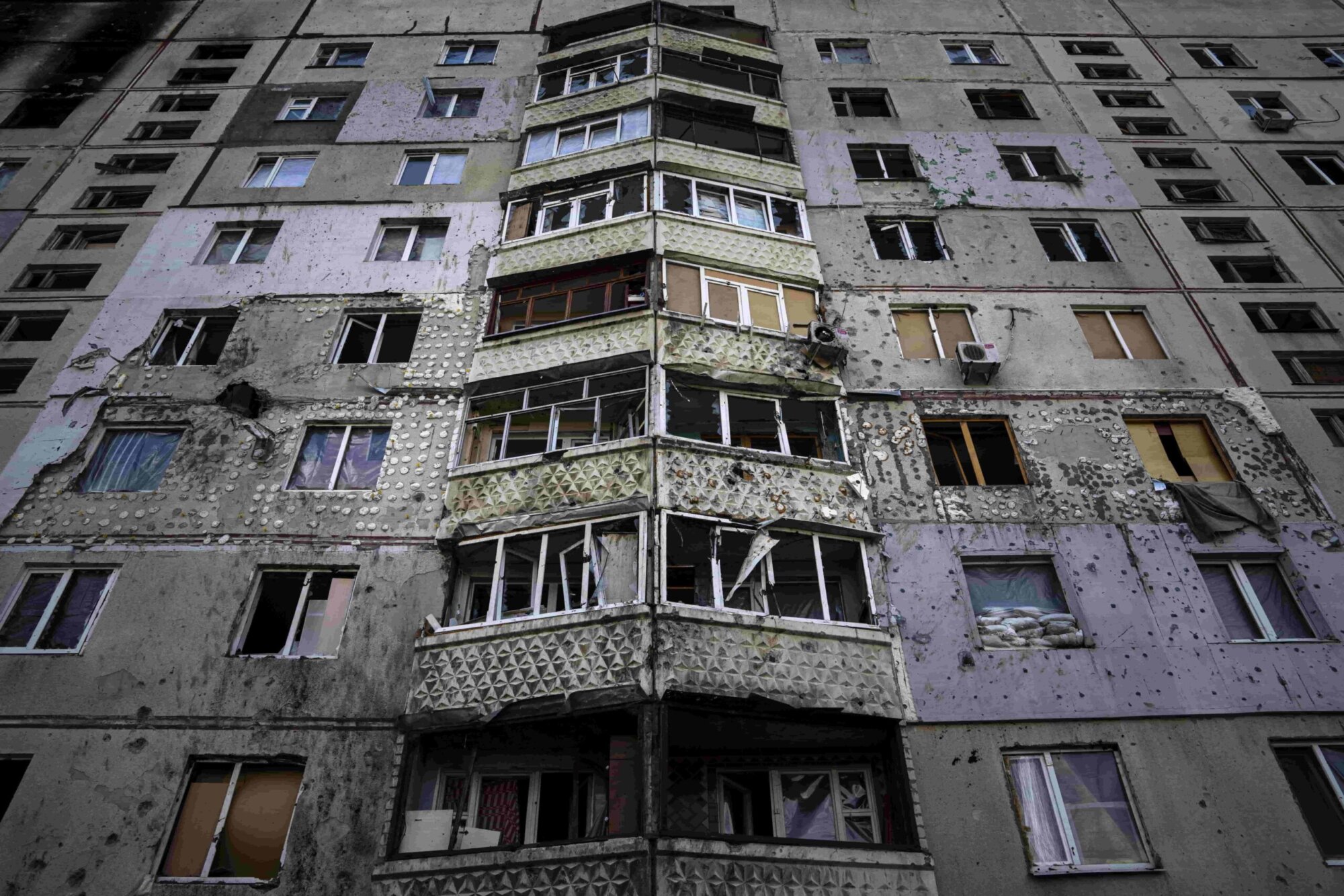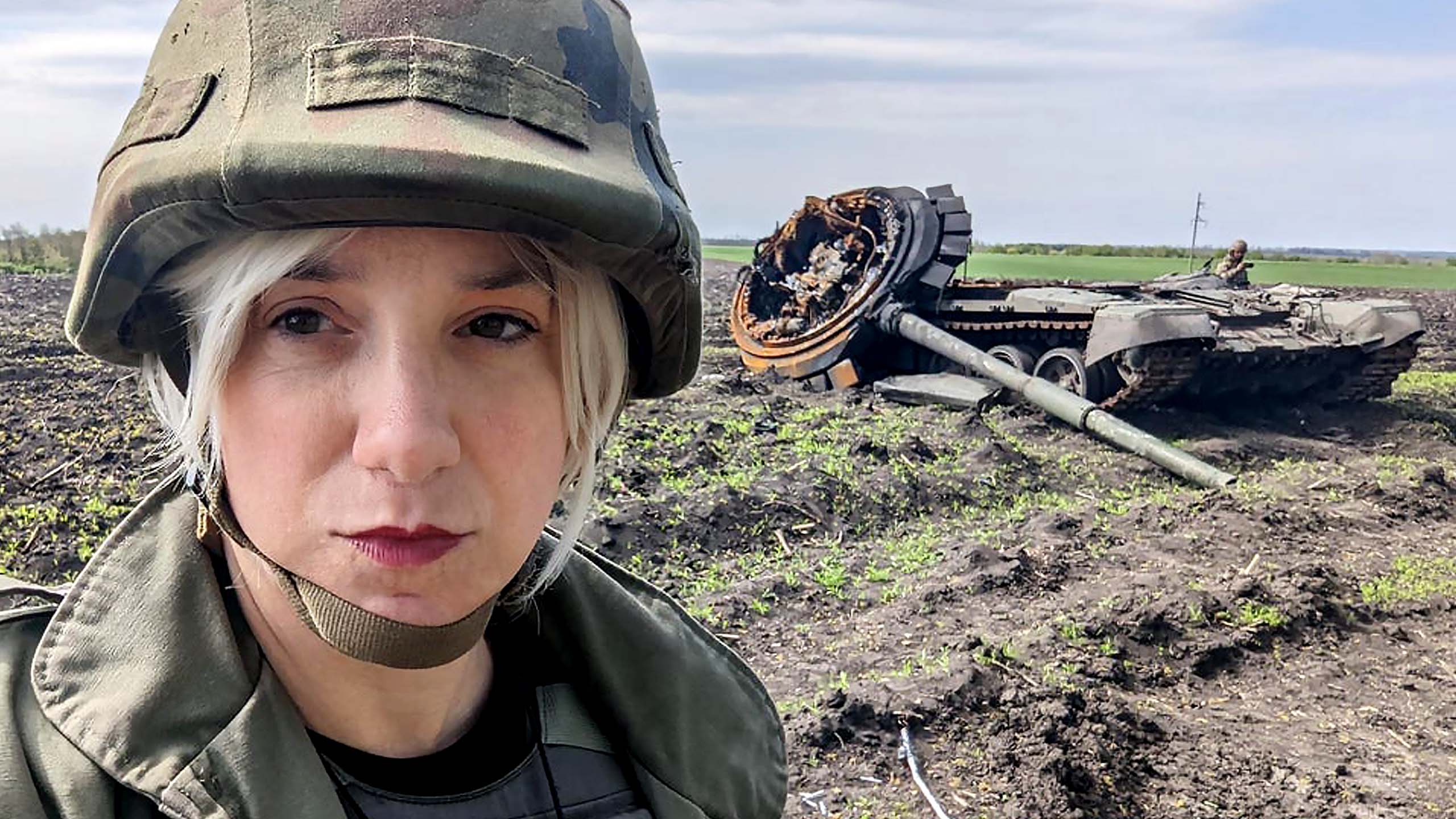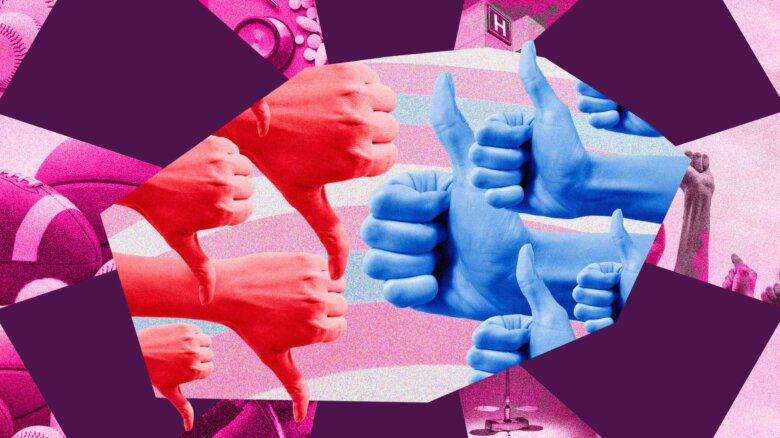Not more than 40 kilometres from the Russian border, in the besieged city of Kharkiv, Ukraine’s only trans war correspondent shelters from rockets and shelling. Sarah Ashton-Cirillo has spent over four months near the front lines, sharing stories from neighbourhoods that few other foreigner reporters are willing to venture into. Her work not only platforms communities that would otherwise be erased by war, it illustrates how, with enough courage, trans people can make space for themselves anywhere.
I first became aware of Ashton-Cirillo when I came to Kharkiv for a week in late May, settling into a relatively safe neighbourhood that hadn’t been shelled for weeks. Most of downtown was ruined, empty and shuttered—broken windows were ubiquitous, as were buildings with holes blasted in them. Military curfew began at 9 p.m., and, as night fell, residents were required to keep their lights off, plunging the city into inky darkness. During the day, it could be difficult to find places to eat. Unlike in other cities, such as Kyiv and Lviv, journalists were scarce.
With Putin’s soldiers being pushed back toward Russia’s borders, the city’s residents were cautiously returning. However, a Russian counterattack was also brewing. The distant booms of warfare, which rolled over the sky like deep thunder, became more frequent. Cascading air raid sirens would awaken residents at night.
I came across Ashton-Cirillo one night while scanning Twitter for more information about rumoured air strikes. Her tweets were prolific—she was often at the scene of recent attacks, by craters and corpses, posting photos and videos describing what had happened. Her reporting on Ukraine had already been published several times in LGBTQ Nation, an American online news magazine, but Ashton-Cirillo was ultimately a freelancer, like many other foreign journalists working in the country. Freelance journalism is a risky profession—most freelancers, Ashton-Cirillo included, self-fund their journeys and have few, if any, support systems in case of danger. Success requires an entrepreneurial spirit and good marketing instincts, which she had—her Twitter following expanded considerably and now provides over 25,000 followers with continuous updates about her experiences.
A trans reporter in this city? It was shocking. More shocking, still, was that she had chosen to live in North Saltivka.
Saltivka is a sprawling residential district covering much of north Kharkiv. Filled with Soviet-style apartment complexes, it housed a third of the city’s population before the war. The destruction there made downtown’s wounds seem trivial. Ashton-Cirillo lived in a rented apartment right in the epicentre of danger, occasionally hosting other journalists. She had been there since almost the beginning of the war, when Kharkiv was a living hell. Her windows had been blown out by neighbouring explosions.

Credit: Evgeniy Maloletka/AP Photo
We agreed to meet for coffee, but the meeting didn’t happen because, shortly after connecting, the Russians shelled downtown for the first time in weeks, killing several civilians about a twenty-minute walk north of where a friend and I were eating lunch. Downtown’s spell of safety was broken and so, on the advice of my family and editor, I left that night.
But Ashton-Cirillo stayed. Throughout the next few weeks, she shared more videos of herself—sometimes beside covered bodies in the daylight, sometimes in absolute darkness, the microphone capturing the terrifying roar of explosions. Some tweets showed the night sky glowing red, illuminated by distant fires.
When I returned to Toronto, we finally managed to do an interview via phone.
“I had no idea. I had never heard of Kharkiv until the war started. There was no inspiration to go to Kharkiv,” she says, explaining that she had originally come to Ukraine to cover the refugee crisis, which would have meant staying in west Ukraine rather than venturing into the war-torn east.
Ashton-Cirillo wanted to report on Ukraine to prove herself. In 2015, she tried to cover the Syrian refugee crisis with mixed results. “I always wanted to write. And [the Syrian crisis] was going to be my first attempt to do Hemmingway, Orwell—see what’s going on. I had time. I was already over there. I had a lot of experience with NGOs in different places, so being in that … very difficult situation was not foreign to me,” she says. Though she hadn’t yet transitioned at that point and lived as a man, she was nonetheless too terrified to venture into Syria. She reported from eastern Turkey instead.
Ashton-Cirillo wrote her first book in just three months, but was disappointed by the result. It felt rushed and improperly researched. “It was awful. One good thing that came out of it was that it got me writing, even while I was working. And so the following year, I published a novel. And the novel was a much better book,” she says.
But the second book also disappointed her, because, yet again, it was written in a frenzy. Ashton-Cirillo was buckling under the realization that she was trans and thought she might kill herself. It was imperative to finish the book before that happened.
“I didn’t wait for any contract. I pushed it out. And I pulled both books from publication after I transitioned because I didn’t feel that they were properly representative of who I was as a human being. I realized in hindsight that I hated myself and wasn’t true to myself as a writer. A lot of what was going through my mind, especially in the refugee book, was, ‘What would these people say if I was trans? What would they do?’ I felt like a liar because I wasn’t living authentically,” she says.
“I realized in hindsight that I hated myself and wasn’t true to myself as a writer.”
But she survived. When the war in Ukraine erupted, Ashton-Cirillo saw it as an opportunity to fix her past mistakes, take her time, and write a book that reflected both her writing skills and realities as a trans woman.
“I didn’t think they would let me into the country. I didn’t think Ukraine was going to let me in as a trans person. I might’ve hated Russia but I was very aware of what some of the things were being said about Ukraine. I wasn’t even sure if Poland would let me in,” Ashton-Cirillo says.
She flew into Berlin and took a train to the Polish-Ukrainian border. It was March 4, less than two weeks since the war began, and the train stations were overflowing with refugees. At the border, Ashton-Cirillo met a group of journalists and aid workers who were getting ready to cross into Ukraine. They knew she was trans and asked if she was planning on coming to Ukraine. “I said yes—but not yet, I was coming up with every excuse … I saw it becoming the sequel to the Syria book, where I was too afraid to go.”
They told her that if she didn’t come with them then, she would never come—she would be too scared and, besides, things would be easier for her if she was in a group. She relented and joined them. There were a few other journalists around, and one of them, who knew of Ashton-Cirillo, approached her and said that it was outrageous that she was going.
“I told her that, if nothing else, I’m doing this for the trans community. It didn’t make it less scary but I was a thousand percent understanding of the magnitude of doing this as a trans person. Just crossing. Just coming into the war.”
Once in Ukraine, the train stopped and security personnel boarded to vet incomers. For 45 minutes, they reviewed everyone’s documents. Ashton-Cirillo was made to take off her wig in front of everyone. “Many people asked me how could the Ukrainians do that to me. I said no. I don’t look at it that way. They were at war. They had to be very careful about the situation and they let me pass. And they let me into their country.”
Ashton-Cirillo’s first destination was Lviv, a large western-Ukrianian city that has acted as a transit hub for those fleeing to Poland. The city was brimming with refugees and there was hardly any space for anyone to stay. A government official asked to meet Ashton-Cirillo along with another journalist. For an hour, the official asked them about their thoughts on the war. Shortly after, Ashton-Cirillo received her media credentials—she was now allowed to go to the front lines.
Lviv didn’t feel as though it was at war. Being deep in west Ukraine, it was far removed from the action. Ashton-Cirillo travelled south, to another city called Ivano Frankivsk, where she reconnected with a doctor whom she had met on the train ride into Ukraine. As Ashton-Cirillo was getting her credentials laminated, they bumped into two men from Kharkiv who worked in security. They told Ashton-Cirillo that journalists were fleeing Kharkiv because of how dangerous the city was, and then asked her, “Do you want to see the war?”
She asked the doctor, whom she barely knew, whether the two men were genuinely security personnel. The doctor said yes. Two hours later, Ashton-Cirillo was in a car heading to the front line, accompanied by two men who were utter strangers to her.
After the first night of the road trip, fear overcame her. “I was so scared. I told them I don’t want to go to Kharkiv. I don’t want to be kidnapped and killed by the Russians.” But the two men were transporting radio equipment for the war effort and could not turn back. They were planning to stop by Dnipro, a city farther away from the action, and asked if they could drop her off there.
“I was so scared. I told them I don’t want to go to Kharkiv. I don’t want to be kidnapped and killed by the Russians.”
“We were about an hour outside Dnipro when I realized that if I didn’t go to the front then, I was probably never going to go. I had no equipment. I had no war-reporting experience. I had never been in the military. I was trans. So I told them to take me to Kharkiv.”
Ashton-Cirillo tells me that just two hours outside of Kharkiv, the men stopped the car. She felt a pang of terror as she realized how defenceless she was—no one knew where she was. What if these men raped or killed her? It turned out, though, that the men were just changing seats. With military curfew fast approaching, the group decided to sleep in their van, parked in the back alley of some town. It was wintertime and they had to keep the heat and lights off to avoid drawing attention. Ashton-Cirillo was very cold, and she heard, for the first time, the sound of rockets and mortars.
“I woke up the next morning and I was still alive. We drove into Kharkiv and I’ve been pretty much here ever since.”
Through her two new friends, Ashton-Cirillo was immediately enmeshed into Ukraine’s security circles and had unparalleled access to the war and its victims. She was given a bulletproof vest and helmet. Wherever the two men went, she went. “I was covering things that no one else was covering. I had access to things that no other reporters had access to.” Her first news story was about a downtown building that had been bombed, killing 50 people. Only upon seeing the dead bodies did she fully understand the scale of death and destruction she was going to witness.
Eventually, she became a volunteer for the army and police, delivering food to them on occasion. She visited a village called Zolochiv, which was north of Kharkiv and only 15 kilometres from the Russian border. She had come to report on volunteers providing relief efforts—the village’s 8,000 residents were being shelled all the time. There was no food and no international groups were brave enough to come.
“I’m interviewing the mayor and I ask, ‘What do they need and what can I do?’ I told the mayor, a couple of days later, to empower me to help him, to make me an official representative of his town and allow me to start reaching out to aid organizations and groups, because people are fucking dying and we’re 15 kilometres from Russia.”
The mayor and town council thought it was a great idea—and thus this Russian-speaking village had a trans representative.
“I see more of the war every day than I could ever have wished to see.”
As the Ukrainians began to get the upper hand in the region and push Russian soldiers farther away from the Kharkiv area, Ashton-Cirillo decided to focus her reporting on civilians and their lives, so she moved into the apartment in Saltivka.
“I see more of the war every day than I could ever have wished to see. I see the fighting in the villages from my balcony. I see rockets coming into the city every day. Buildings have been hit in front of me. I’ve been doing live interviews where rockets have landed. My whole life is now consumed by war.”
Local Ukrainians have been unexpectedly accepting of her trans identity. “For the first month, the only thing that was ever said to me about being trans was a reference one time to a photo of me pre-transition, which someone saw on Instagram.” Many civilians don’t realize that Ashton-Cirillo is trans, but the security personnel she works with are aware. Even so, they have never made an issue about it. “In day-to-day life, it never comes up unless people want to ask me a question. It never comes up. It’s the wildest thing.”
Ashton-Cirillo’s experience reflects a larger shift in Ukrainian LGBTQ+ acceptance. According to numerous LGBTQ+ activists and community members I interviewed, Ukrainians have become more accepting of the LGBTQ+ community since the mid 2010s, especially among younger generations and in urban areas. Simultaneously, the Ukrainian government has consistently passed pro-LGBTQ+ legislation in a bid to Europeanize the country.
Much more work still needs to be done, but the war appears to have boosted LGBTQ+ acceptance, as Ukrainians have set aside old prejudices to fight a common existential threat. Hardcore nationalists who were previously hostile to LGBTQ+ rights have softened their views—many now state that they do not care about gender or sexual orientation for military recruitment. For them, war has acted as accidental DEI training.
LGBTQ+ Ukrainians have been highly visible throughout the war, wearing unicorn and rainbow patches on their army uniforms and posting about their experiences on social media. Ukraine is even considering legalizing same-sex marriage—a move that was unthinkable last year.
“That’s another thing I learned about war—it’s the great equalizer,” Ashton-Cirillo says. “There’s a long way to go, but very real progress has been made from Ukraine’s government and society over the last six or seven years, and I think that my experience is absolutely part of that.”
Ashton-Cirillo says that it has been easier for her to be trans in Ukraine than in the United States. “In the United States, people want to objectify trans folks, and the entire LGBTQ+ community, as a wedge issue. And in Ukraine? If Sarah is willing to fucking go to Russia, we don’t care that she’s trans because there’s nobody else here. She’s come on missions with us where we’ve been shelled. Or she kept on filming as a rocket hit behind her. That’s what matters to them.”
However, there are some hiccups now and then. Sarah’s military credentials are just like any other journalist’s but, beneath her name, in much smaller font, is her deadname (“formerly known as XXX”). Though she is unhappy with this constant reminder of her old self, she believes that it makes it easier for her to operate in Ukraine, in case officials are confused by her other documents.
On rare occasions, some soldiers have made jokes about who will do sexual things to her—but Ashton-Cirillo calls such transgressions “very limited” and chalks them up to misogyny. “They’re like middle school boys. My gender only matters in the sense of it being a conservative society and, as a female, there’s been some misogyny and patriarchy issues—nothing to do with being trans.”
Here on the ground in #Kharkiv is the fresh blood of #Ukraine.
Blood spilled by Russian terrorism.
Don't look away. pic.twitter.com/rnS5jvXOeL
— Sarah Ashton-Cirillo (@SarahAshtonLV) July 20, 2022
Ashton-Cirillo ’s social media updates, which often drip with indignation at the violence around her, have earned a large Twitter audience—in just a few months, her follower count ballooned from 1,700 to over 25,000.
But with new fans comes new critics. Russia’s Ministry of Foreign Affairs (MFA) accused Ashton-Cirillo of being a Nazi who took photos with gangsters, and argued that her existence showed that there is no distinction between queers, Western journalists and Nazis. The MFA also insinuated that Ashton-Cirillo helped murder Gonzalo Lira, a pro-Putin Ukrainian-based blogger who hadn’t been heard from in a few days at that point (Lira would later reappear, unharmed).
Shortly after Russia slandered Ashton-Cirillo as a murderer, the claim was parroted by Joe Oltmann, an American far-right commentator who is infamous for amplifying conspiracy theories about voter fraud. Oltmann called Ashton-Cirillo a Nazi and accused her of working with the Ukrainian military to behead Lira. When Lira showed up alive and well, Ashton-Cirillo sued Oltmann for defamation; the lawsuit is currently working its way through the U.S. legal system.
Ashton-Cirillo’s Twitter account remains a lightning rod for harassment. “I get death threats, kidnapping threats and torture threats every day. Every day. And Twitter does nothing about it.” Pro-Russian trolls doxxed her, publishing her personal information online. The Ukrainians told her to wear it as a badge of honour. “I fucking hate it. It’s traumatic. But it gave me credibility,” she says.
As of now, Ashton-Cirillo remains in Kharkiv and is in the midst of writing her new book, Trans at the Front, which she is releasing on Substack in serialized chapters. With shelling intensifying, she has moved to a slightly safer neighbourhood, though she remains very close to the action.
“A trans war reporter on the Russian border working with Ukrainians during a war? One that’s from the United States? It shouldn’t be real, but it is. I want people to understand that if somebody is trans, non-binary, Two-Spirit, gay, lesbian, whatever their identity might be, sexually or gender-wise, anything is possible.”


 Why you can trust Xtra
Why you can trust Xtra


